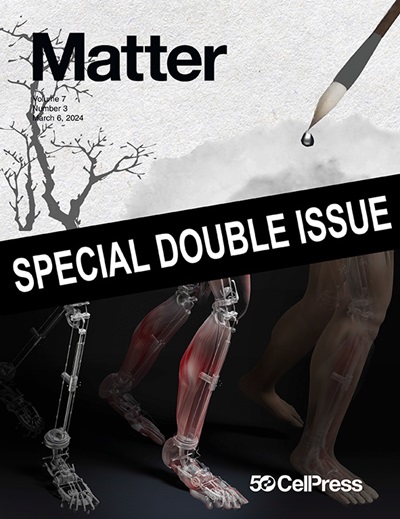Expanding the processing space of quantum confined, one-dimensional titania-based lepidocrocite nanofilaments
IF 17.5
1区 材料科学
Q1 MATERIALS SCIENCE, MULTIDISCIPLINARY
引用次数: 0
Abstract
In this study, we expand the processing space of new, quantum-confined one-dimensional lepidocrocite (1DL) titania-based nanofilaments (NFs). Our previous work to date entailed reacting Ti-precursors (e.g., TiB2, TiOSO4, TiN, TiC, etc.) with the quaternary ammonium compound (quat) tetramethylammonium hydroxide (TMAH) for tens of hours under ambient pressures at temperatures ranging from 50°C to 80°C. Herein, we expand the list of quats that result in 1DL NFs to tetraethylammonium hydroxide (TEAH), tetrapropylammonium hydroxide (TPAH), tetrabutylammonium hydroxide (TBAH), and choline hydroxide (ChoH). We also show that tetrabutylphosphonium hydroxide (TBPH) can be used to the same end result. These quats and TBPH are less toxic than TMAH, especially Cho+, which is fully biocompatible. And, while all the quats and TBPH result in the same 1D product, their de-flocculation in various organic solvents is different. Reacting with less polar quats (e.g., TBA) and washing with less polar solvents (e.g., dichloromethane) favors the formation of porous mesostructured particles. 2D structures are favored if the opposite is chosen. Said otherwise, by the judicious choice of a quat (e.g., TPAH) and solvent (e.g., tert-butanol) combination, we produced stable 1DL colloidal suspensions in dimethyl sulfoxide, methanol, ethanol, acetonitrile, isopropyl alcohol, butanol, and acetone. This enhanced colloidal stability is critical in applications in coatings, inks, and catalytic systems where non-aqueous stable dispersions are paramount. The high band-gap energies, Eg, measured (3.8–3.9 eV) confirm quantum confinement. The Eg are also quite insensitive to d spacings between the 2D sheets. These 1DLs exhibit significant adsorption and dye (rhodamine 6G) degradation capabilities. For example, TEA-1DL colloidal suspensions adsorb 64% of the dye in the dark in about 5 min and decolorize 99% of the remaining dye within 30 min under the irradiance of one sun.

扩展了量子受限的、一维钛基鳞球石纳米丝的加工空间
在这项研究中,我们扩展了新的,量子限制的一维鳞片石(1DL)钛基纳米纤维丝(NFs)的加工空间。到目前为止,我们之前的工作需要在50°C到80°C的环境压力下,将ti前体(例如,TiB2, TiOSO4, TiN, TiC等)与季铵化合物(quat)四甲基氢氧化铵(TMAH)反应数十小时。在此,我们将导致1DL NFs的quats列表扩展到四乙基氢氧化铵(TEAH),四丙基氢氧化铵(TPAH),四丁基氢氧化铵(TBAH)和氢氧化胆碱(ChoH)。我们还表明,四丁基氢氧化磷(TBPH)可以用于相同的最终结果。这些quats和TBPH的毒性比TMAH小,尤其是Cho+,它具有完全的生物相容性。而且,虽然所有quats和TBPH都能产生相同的1D产物,但它们在不同有机溶剂中的脱絮效果不同。与极性较少的溶剂(如TBA)反应和与极性较少的溶剂(如二氯甲烷)洗涤有利于多孔介结构颗粒的形成。如果选择相反的结构,则青睐二维结构。另外,通过明智地选择四元(如tpaa)和溶剂(如叔丁醇)组合,我们在二甲亚砜、甲醇、乙醇、乙腈、异丙醇、丁醇和丙酮中生产出稳定的1DL胶体悬浊液。这种增强的胶体稳定性对于涂料、油墨和催化系统的应用至关重要,在这些应用中,非水稳定分散体是至关重要的。测量到的高带隙能量,例如(3.8-3.9 eV)证实了量子约束。Eg对2D薄片之间的间距也相当不敏感。这些1dl具有显著的吸附和染料(罗丹明6G)降解能力。例如,茶- 1dl胶体悬浮液在黑暗中约5分钟即可吸附64%的染料,在一个太阳的照射下,30分钟即可脱色剩余99%的染料。
本文章由计算机程序翻译,如有差异,请以英文原文为准。
求助全文
约1分钟内获得全文
求助全文
来源期刊

Matter
MATERIALS SCIENCE, MULTIDISCIPLINARY-
CiteScore
26.30
自引率
2.60%
发文量
367
期刊介绍:
Matter, a monthly journal affiliated with Cell, spans the broad field of materials science from nano to macro levels,covering fundamentals to applications. Embracing groundbreaking technologies,it includes full-length research articles,reviews, perspectives,previews, opinions, personnel stories, and general editorial content.
Matter aims to be the primary resource for researchers in academia and industry, inspiring the next generation of materials scientists.
 求助内容:
求助内容: 应助结果提醒方式:
应助结果提醒方式:


